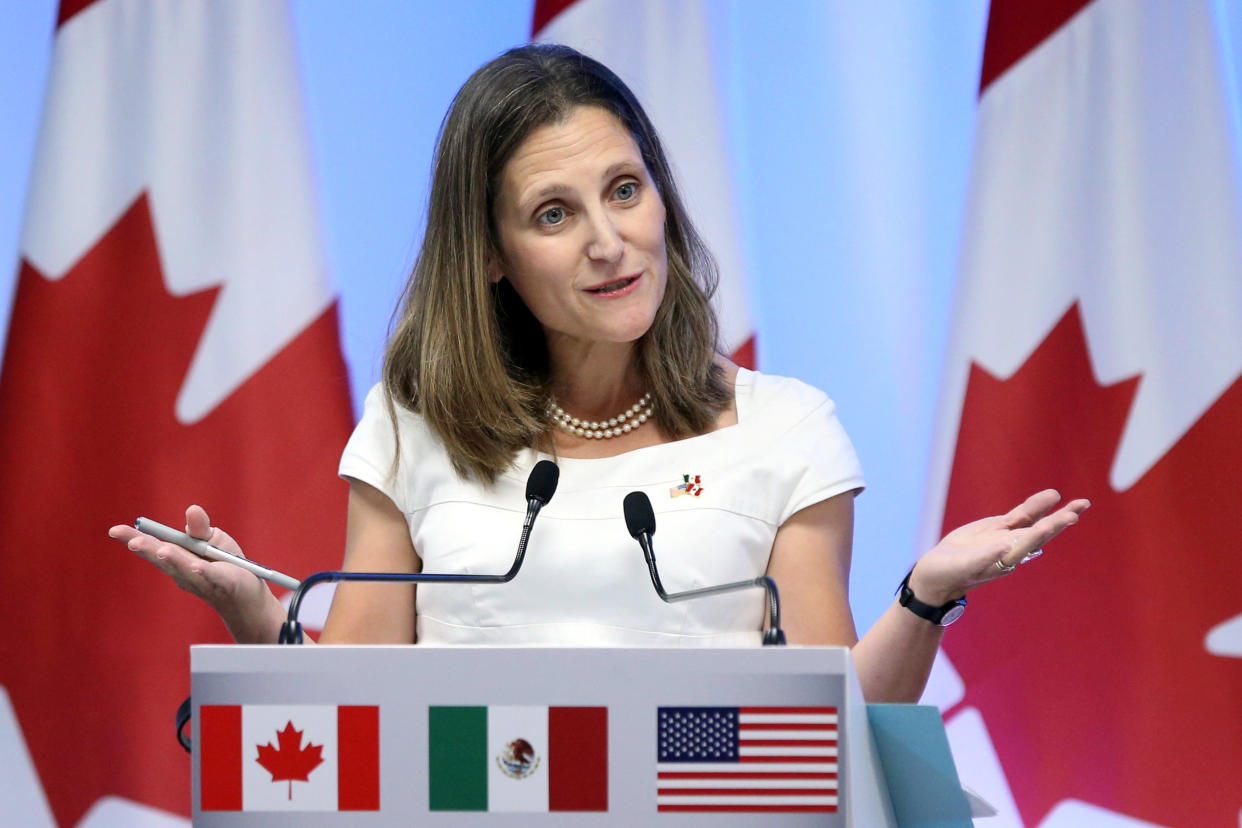Loonie faces a shocking plunge if NAFTA doesn't get a rewrite

Analysts have warned that failure to rewrite the North American Free Trade Agreement is apt to drive the Canadian dollar downwards to the mid- to low-60 cents against the greenback. But it could also rewrite Canada’s economic approach.
Political posturing and antagonism have pockmarked negotiations of the three-nation pact, since U.S. President Trump’s trade team officially came to the table in August. While the process is likely to flow into 2018, analysts have already begun outlining their doomsday scenarios for a post-NAFTA world, and in them, the Canadian dollar is in for a shock.
In JPMorgan Chase & Co.’s October note, a team of strategists led by Daniel Hui warned that: “Even if the only trade relationship materially disrupted is the U.S.-Mexican one, Canada would still suffer from negative impacts due to the disruption of supply chains that span all three countries.”
If that happens, the loonie could fall from the high 70-cent range where it stands now to 66- or 62-cents against the U.S. dollar.
“The Canadian dollar, though less vulnerable to a NAFTA breakdown than the peso, could move to the 1.34-1.38 per dollar range if such a scenario were to play out that included an unwinding of recent Bank of Canada hikes and a weakening of WTI (West Texas intermediate crude) oil prices to around $35 a barrel,” he says.
Walid Hejazi , an associate professor of economic analysis and policy at the University of Toronto’s Rotman School of Management, says that the JPMorgan number is reasonable assuming “you snap back to the Canada-U.S. Free Trade Agreement.”
“If we don’t… it’d be much worse,” says Hejazi. “There’s no question that a disruption to the NAFTA is going to hurt the Canadian economy and with that, it’s going to take the wind out of our sails.”
One of the obvious immediate impacts would be an unwinding of the Bank of Canada’s benchmark overnight rate, which was increased twice this year by a quarter-of-a-percentage-point in both cases.
“(But) we don’t have much room to unwind,” says Isaac Holloway , assistant professor in the business, economics, and public policy group at Western University’s Ivey Business School. “It’s fairly likely that the Fed might hold off on its rate tightening as well.”
In other words, if the Bank of Canada drops rates by another quarter of a per cent or even a full 50 basis points and the Feds hold, there will likely be some downward pressure on the Canadian dollar.
“The thing about NAFTA is it’s a trade agreement so to some extent, if both Canada and the U.S. revert back, we’re still looking at zero tariffs for most goods,” he says. “So the bilateral relationship is not going to be facing more tariffs, it probably is more of a business uncertainty environment that’s the problem.”
And Canada would bear the brunt of that uncertainty from an export perspective. According to research by University of Calgary economist Trevor Tombe, Michigan and Vermont are the only U.S. states where trade with Canada exceeds 10 per cent of their annual economic output. Compare that with Canadian provinces like Ontario where 49 per cent of its GDP depends on trade with the U.S., Alberta, where it’s 31 per cent and Quebec where the U.S. makes up 23 per cent of the province’s GDP.
“All of our supply chains are linked into the U.S.,” says Hejazi. “It would be incredibly disruptive, as these supply chains have to become re-oriented.”
But, in some ways, says Hejazi, it offers an opportunity to examine the value of putting too much stock in the U.S. as a trading partner.
“The sub-story to all of this is Canadian companies – and the government needs to encourage this – need to increase their footprint in emerging markets, we don’t want to be too vulnerable to the Trumps of the world,” he says. The positive spin is the falling dollar makes our exports easier (read: cheaper) to sell elsewhere.
Holloway is quick to point out that while finding new trade partners is a conversation that should be had in light of the current U.S. administration, “deliberately saying they want to cut their ties to our economy and build a metaphorical wall through getting out of these trade agreements,” diversifying is easier said than done.
“If we think of the economic law of gravity, you’re going to trade more with countries that are big and you’re going to trade more with countries that are close,” he says. “And (that law) is difficult to break – especially for a province like Ontario which would have so far to go to have someone like China replace its trade relationship with the States.”
Holloway points out that while it’s important to discuss the potential impact on the Canadian dollar, “it’s very difficult to forecast the degree to which markets and businesses get scared off by a collapse of NAFTA .”
“We could make some educated guesses but frankly, we don’t really know,” he says adding that there are sectors that benefit from a low dollar like the tourism sector and exporters who aren’t facing any other tariffs. “We’ve had a fairly low dollar (recently) in a sense that we’re not at parity like we were a couple years ago, so there’s been some lead time for firms to think about a strategy.”
Download the Yahoo Finance app, available for Apple and Android.


